South Australian trekkers stuck in Nepal amid coronavirus lockdown
A group of SA trekkers were on the trip of a lifetime hiking to Mt Everest Base Camp. They’re now in a living nightmare in Nepal, stranded with no guarantee of when they’ll get home.
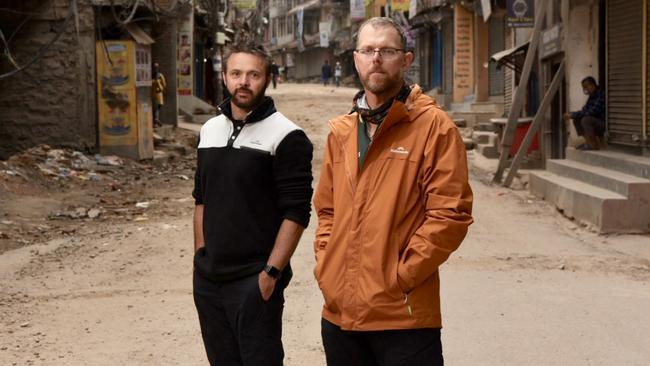
Coronavirus News
Don't miss out on the headlines from Coronavirus News. Followed categories will be added to My News.
- The growing list of SA workers being stood down, sacked
- How to get the most from your Advertiser subscription
We were stranded with our luggage outside the locked gates of Kathmandu’s international airport.
Nepal had gone into lockdown, and people were being ordered off the streets. Our flights had been cancelled and roads were shutting down.
When police and army personnel, some armed with riot gear and machine guns, started shouting menacingly at vehicles and pedestrians violating the new lockdown rules, we knew we might be in trouble.
We had made our way to Nepal’s Tribhuvan International Airport by 5am in the hope that our flights home might still be departing.
The Nepalese government had announced the lockdown previous night in an effort to manage the coronavirus pandemic.
For a month, the country’s official COVID-19 tally had been just one - a 31-year-old student who had returned from Wuhan and had since recovered.
But after a 19-year-old student tested positive to becoming Nepal’s second official victim, the government acted swiftly and implemented a seven-day lockdown, starting 6am Tuesday.
When news came through of the lockdown the previous night, our group of eight was booked on two separate flights home the next day.
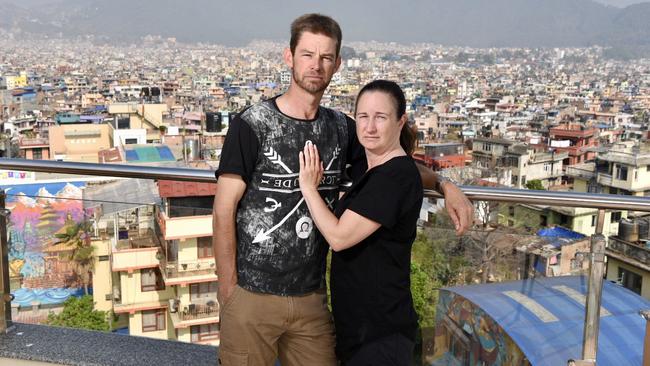
Our initial flights home via Singapore and Kuala Lumpur had already been cancelled so we had spent the previous days desperately searching for alternative flights.
Some had managed to book an Etihad flight leaving at 4.50pm on Tuesday, the day of the lockdown. Others were on an Etihad flight for the Friday.
Both Etihad flights were due to transit through Abu Dhabi, so our hearts sank when it was announced on Monday afternoon that the United Arab Emirates government would ban passenger flights to and from the country from 11.59pm on March 24.
This meant that those booked on the Friday flight would need to change plans.
They dug deep into their credit cards again and booked on a Qatar flight leaving the next day.
At dinner that night it was decided that those on the 11.25am Qatar flight would be picked up from our hotel at 7.30am. The rest of us, still booked on the Etihad flight, would leave for the airport about 1pm.
These plans changed an hour or so later as we were preparing for bed, when we heard of the Nepalese government’s lockdown.
There was little clarity about what the lockdown would mean for tourist transport but after a few phone calls, we decided it would be best for us to be at the airport before the 6am lockdown came into effect.
It was going to mean a long day waiting around in an airport with few luxuries for those of us booked on the 4.50pm Etihad flight, but we figured it was better to be safe than sorry.
So we set our alarms for 3.30am and tried to grab a few hours’ sleep. It been a stressful few days, but it looked like we were finally on our way home.
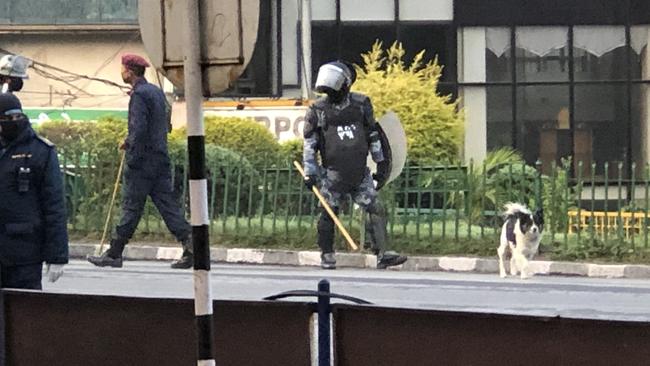
MORE NEWS:
Inside an Adelaide coronavirus-inspired ‘micro-wedding’
Dan Wills: Black and white reality dawns on a new world
Any thoughts of a restful night’s sleep were dashed around midnight, when news came through that the next day’s 4.50pm Etihad flight had been cancelled.
The 11.25am Qatar flight was still scheduled to depart though, so the five who were booked on the Etihad flight woke from our slumber, jumped on the Qatar website and rejoiced when we were able to book onto the earlier flight.
Credit cards had taken another bashing, but the silver lining was that we would all be on the same flight home, and we wouldn’t need to wait around in the airport for more than 12 hours.
When the alarm went off at 3.30am though, there was more worrying news. A flight tracker website was showing that the Qatar flight had also been cancelled – just three hours after our tickets had been booked.
No-one had received any official confirmation from the airline though. We had become accustomed to emails from airlines telling us that our flights had been cancelled, and, so far, none of these had yet come through for the Qatar flight.
Information and misinformation had become a currency in the past few days and it was becoming impossible to know what we should believe.
In the absence of any official confirmation either way, we decided to press ahead with our plans to get to the airport before the national lockdown.
Even if our flight was cancelled, we figured, our best chance of finding another flight was at the airport.
Our hopes dropped, though, when we arrived at the airport entrance only to be turned away. It was closed.
But it was unclear if it was closed purely because it was 5am or if it was closed because of the national lockdown.
More than a dozen or so other travellers were already mulling near the front gates with their bags so we decided to join them.
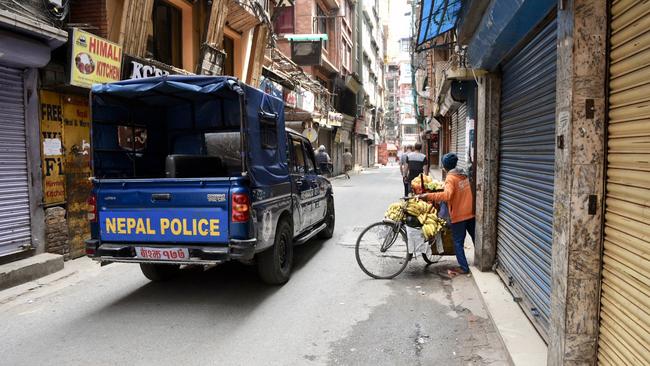
We said goodbye to our trekking group’s tour guides who had accompanied us to the airport. They were anxious to get off the streets before the 6am curfew.
We were now left to our own devices, and tensions and uncertainty rose as the minutes ticked down towards the lockdown deadline.
The sun was yet to rise, but armed services soon established a roadblock near the airport, and taxis arriving to take stranded travellers back to their accommodation were turned away, empty.
By 6am there were about 100 confused foreigners, including one young family, being ordered to move on. We could no longer congregate where we had been told to wait, in an open shelter just outside the entrance, only an hour ago.
We were ordered to haul our luggage through a guarded gate into the airport’s car park, and await further instruction.
Confusion reigned supreme. One of our party became separated in the chaos.
He had been sent a different direction by an officialdom still struggling to come to terms with the lockdown, and was wandering the street alone.
We spoke gently to an officer now guarding the car park, and were allowed to track down our lost friend and bring him back into the fold.
By the time the group was reunited, officers in the car park were directing people to take their luggage and return to the streets - but no more than two at a time in line with new social distancing regulations.
We were now officially stranded. Our hotel was more than an hour’s walk away, longer with luggage, but we had already been told it was closing down because of coronavirus.
Most other hotels were doing the same.
Then a white knight from the Australian Embassy came to our rescue. Literally.
Emma Stone is the wife of the Australian Ambassador to Nepal, Pete Budd.

Like her husband, she had been following our plight on a Facebook page we had created a few days earlier. Fortunately, she was online that morning and had seen some pictures we had posted outlining the situation unfolding at the airport.
She messaged the group, asking how many Australians were caught there, where, exactly we were, and said she was on her way to pick us up.
The official plates on her car would allow her pass through the roadblocks, she posted, so we needed to just sit tight until she got there.
Her message was like a missive from heaven, offering a ray of hope in a situation which was fast spiralling out of control.
We spoke with the Nepalese policeman who was minding our movements, and explained that the Australian Embassy was coming to pick us up.
We explained that Emma was in an official car with the correct coloured plates. He seemed happy with that information, and allowed us to wait in the car park.
If her initial post that she was on her way was a relief, then seeing her drive in, wind down her window and ask if we were the Australians was something totally out of this world.
Words will never be able to adequately describe how grateful we were for Emma what she did for us that morning.
She needed two trips to get the eight of us, and our luggage, off the streets. She ferried us to the Australian Embassy, where we all passed a temperature test- now mandatory before entering almost every hotel or building - and filled out some official documents.
Her generosity continued as she invited us into her home, opened up her kitchen and lounge room, let us connect to her Wi-Fi and even offered Australian power points to charge our phones.
Best of all, though, she offered us toast with … wait for it …. VEGEMITE. We couldn’t have been more excited with this latest development.
We had now been in Nepal for nearly three weeks, having left Australia on March 2 for a trip which had been in the planning for 18 months, and a taste of home was just what the doctor ordered.
We had cut short our Himalayan trekking expedition - which had taken us from Lukla, to Gokyo, across the Cho La Pass and on to Everest Base Camp - when we heard Department of Foreign Affairs advice for all overseas travellers to return home immediately.

For us, this was easier said than done. Once we read this DFAT advice, we had hightailed it back to Lukla at double pace in an effort to get back to Kathmandu as early as possible. But then the weather gods intervened.
As often happens in Lukla, consistently listed as most dangerous airport in the world, the clouds came in and all flights were cancelled.
The only other way back to Kathmandu was via a multi-day hike followed by a long jeep ride.
So we decided to wait it out and hope for better luck the following day.
On Saturday morning, the clouds opened and our spectacular half-hour flight back to the Nepalese capital touched down about 7.30am. But by then our window of opportunity to change flights had severely diminished.
We had read online reports in the previous few days that the international airport would close on Monday for both incoming and outgoing flights.
But we were yet to receive any notification from our airlines that our flights home were cancelled, so we headed straight from the domestic terminal to the international terminal to make sure it was still open. It was. So we then went direct to our airline offices in the city, where dozens of other travellers from across the globe were also starting to queue.
We waited on the streets for a few hours, but it soon became apparent that the offices would not be opening that day.
But our time waiting for the airlines to open was not completely wasted. Following the lead of a group of Australians in a similar situation in Peru, we decided to start a Facebook group called Australians Stranded In Nepal.
We figured there was power in numbers, and the more Australians we could find in the same situation as us, the more chance we would have of finding a solution.
We wanted to compile some sort of list of everyone trying to get home and put out a call for others to give us their details.
We invited everyone we knew to be part of the group, and asked them to spread the word. Within 24 hours, the group had grown to include nearly 400 members, more than 40 of whom were trying to find a way home. There are now about 800 members and the list of stranded Aussies (which now also includes New Zealanders) has grown to more than 200.
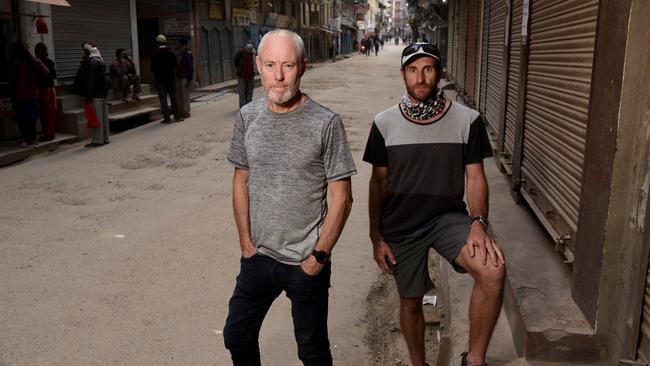
A front page report in The Himalayan national newspaper confined earlier rumours that the international airport was closing down from Monday, and we went online, without luck, to find any available seats within this time frame.
Because it was a Saturday morning, the Australian Embassy was closed but a security guard at the front gate directed us to the government’s smart traveller website for advice.
So we returned to our pre-booked accommodation at the Kathmandu Guest House in the popular tourist haven of Thamel. The guesthouse was still open, just, but restaurant options were becoming limited.
The streets of Thamel, which had been bustling with locals, tourists, traders, hostels, hotels, pool halls, trekking companies, rickshaws, push bikes, taxis and buses when we had arrived just over two weeks previously, were gradually winding to a halt.
By midmorning on Sunday though, we had received a bright ray of hope. One of the wives of our trekkers had noticed a new announcement on the Tribhuvan International Airport website which said it was staying open for international departures.
It was game on again.
Within minutes we had all booked flights home and spirits were as high as they had been since we took off safely from the treacherous Lukla airstrip.
We were resigned to the fact that this trip would end up costing a lot more than we had intended because most travel insurance companies specifically rule out reimbursing any extra costs caused by a global pandemic.
When we left home on March 2, the coronavirus was yet to be declared a pandemic, and was still mainly contained to China, Italy, Iran and South Korea.
All of us had been watching the virus developments closely, but none of our group of eight ever considered postponing our trip.
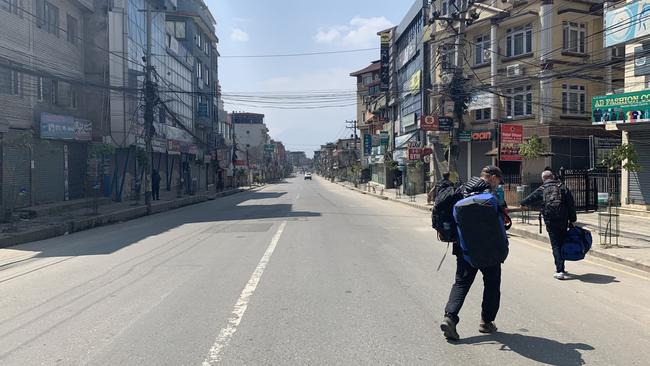
Nepal had reported just one case of the virus and there was no travel advice urging us to rethink our plans.
With the benefit of hindsight, we were perhaps a little naive, and we copped a fair share of flack on social media when our plight was first published in The Advertiser earlier this week.
We can understand some of the backlash but are keen to reiterate that none of us was ever looking for a free trip home, and the extra flight and accommodation costs will be a financial blow to us all.
Back at the Australian Embassy on Tuesday morning, as we were eating our vegemite on toast, a few of us helped transfer the Facebook list of stranded Aussies in Nepal to a spreadsheet and passed it over to embassy staff to manage.
By then the list had grown to more than 60 names. About 12 hours later, Pete Budd released a statement saying the list was nearly 200-strong and he was working with airlines and the Nepalese government to allow a plane to come in and pick us up.
By lunchtime Tuesday, indefatigable Emma Stone and embassy staff helped us find new accommodation, at the Hotel Moonlight back in Thamel, and drove us to our new haunt in two new Toyota four-wheel-drives.
We’ve spent the last few days killing time around the hotel, meeting in the restaurant for breakfast, lunch and dinner and venturing outside sparingly in line with new social distancing regulations. We have even started a daily rooftop gym class to help overcome the boredom.
The staff here at the hotel have been amazing, as has every Nepali we have come in contact with over the past month or so.
The Facebook page continues to grow and it appears there are still many Australians trying to return from remote mountain tops to Kathmandu in the hope of getting a flight home.
For us, though, it’s just a matter of sitting tight, looking after each other’s physical and mental health and waiting patiently for a long-awaited flight home.
